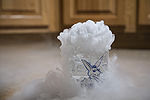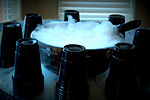Dry ice
Dry ice is the solid form of Carbon dioxide. Instead of going from the gaseous state to a liquid to a solid, Carbon dioxide jumps straight from a gas to a solid. Dry ice has many uses because of how cold it gets; it is -109.3°F. Dry ice can be used for anything from flash freezing to removing dents from a car. But along with its great qualities, Dry ice also has some problems; it will sublimate quickly if exposed to water, producing large quantities of Carbon dioxide. In an ice chest it will also begin to sublimate, so like ice (made from water) Dry ice does have a shelf life. [1]
Manufacturing
Dry ice is made from Carbon dioxide (CO2). First Carbon dioxide must be converted to its liquid state through pressurization, and then this liquid Carbon dioxide is kept under a constant pressure in tanks to keep it at its liquid state. As the liquid Carbon dioxide is exposed to air at its normal temperature (STP) some of it is converted into Carbon dioxide gas. The remaining liquid Carbon dioxide freezes as snow. The snow is compressed to make blocks or pellets. The snow is pressed using a hydraulic block press, to be used for many different purposes or the snow can be pushed through a dry ice pelletizer to become pellets that also have many different purposes. [2]
Safety
It is not safe to handle Dry ice with exposed skin. If you briefly touch a piece of Dry ice, you will be fine. However, if your skin is exposed to Dry ice for more then a few seconds, you may sustain frostbite or a burn similar to a heat burn, because Dry ice is -109.3°F. This why it is only safe to handle Dry ice with leather gloves or something similar to them like a protective cloth or oven mitts. You should treat any burn received by the Dry ice like you would a normal heat burn.
Dry ice must be stored in a well insulated container to insure that it doesn’t melt. However, that does not mean you should leave it in an airtight container because as it sublimates (changes states from a solid directly to a gas) its pressure increases. That means that the container that it is in would explode or simply expand. Also Dry ice needs to be stored in a well ventilated room so that as the Dry ice sublimates, the Carbon dioxide that is released will have somewhere to go. If it stays in a confined space it will push any oxygen in the room up, this could lead to a person suffocating if they are in the room. [3]
Uses
Uses for Dry ice:
- Camping
- Hunting or Fishing
- Picnic, Beach or Boating
- Backpacking
- Tailgating
- Halloween
- Fundraising
- Severe weather
- Couriers
- Traveling
- Deep Sea Fishing
- Flash Freezing
- Recipes
- Special Effects [4]
- Eliminating Hair Loss for Chemotherapy Patients
- Killing Gophers and Moles in Lawns
- Removing Bed Bugs
- Killing Clothes Moths
- Preserving Seeds And Grains
- To Remove Flammable Fumes from Fuel Tanks
- To Remove Oxygen and other Hazerdous Materials from Tanks
- To Cool Asphalt
- Cold Grinding
- Speeding Up Computer Chips
- Beverages
- Remove Car Dents and Dings
- Make Glass
- Shut Off Water Pipe For Repairs
- Power Machines
- Dry Ice Blasting
- Catch Mosquitoes
- Flash Freezing
- Freeze Branding
- Rainmaking
- Canning
- During Power Outages [5]
- Dry Ice Bombs
History
In 1835, a French chemist named Thilorier was attempting to observe liquid Carbon dioxide. He opened a container containing liquid CO2 only to have most of it evaporate, leaving behind only Dry ice. He is the first person to actually record a solid form of Carbon dioxide. After that Dry ice was studied but never used for any actual purpose until in 1897 Herbert Samuel Elworthy received a patent for Dry ice. He enjoyed having soda water mixed in with his whisky; originally he had used liquid Carbon dioxide. However, the containers that liquid Carbon dioxide must be kept in to keep it in its liquid state were extremely heavy. He was a doctor in the British Army Medical Corps, so he needed to be able to travel. In place of canisters of liquid Carbon dioxide he tried Dry ice; however this did not last long because when Dry ice gets warm it quickly becomes Carbon dioxide gas. [6]
In 1933, an Italian physician named Dr. M. Matarasso instead of using Dry ice for beverages devised a means of removing freckles or possible moles using Dry ice. He had Dry ice snow compressed into a pencil like shape with a small point on one end; he used this end to press on a person’s blemish for about three seconds. After about two weeks the blemish would fall of leaving behind only white blemish free skin. This was due to the fact that after a short while of contact Dry ice will freeze a person’s skin, the frozen blemishes in the doctor’s case simply would fall off after a while. [7]
The first company to use Dry ice commercial and attempt to make a profit off of it was Prest Air Devices. They started with simply looking for a way to make a profit off of compressed Carbon dioxide; they were successful with marketing fire extinguishers. They began trying to sell Dry ice in 1924 as a way of keeping products cold during transportation on railroad cars. Dry ice is a much better choice than ice because it keeps things twice as cold as ice, and it does not melt leaving behind large amounts of water, instead it evaporates directly into Carbon dioxide gas. In 1925, believing that they would have a large demand due to railroad companies, Prest Air Devices began constructing a production plant for Dry ice. During this time they were sold and incorporated into the DryIce Corporation of America, known mostly as DryIce. DryIce was unable to get a patent for Dry ice due to the U.S. Supreme Court turning them down. The DryIce Corporation in 1932 had made twelve railroad cars that were able to keep products cold using Dry ice through transportation. However Dry ice was beat out for railroad cars business by mechanically refrigerated cars.[6]
DryIce Corporation of America had their first customer in 1926. It was Schraff’s Stores; they sold a variety of things including Eskimo Pie ice cream. Schraff’s Stores wanted some sort of packaging that would keep their ice cream cold enough that their customers could bring it home and eat it. Before they tried Dry ice Schraff’s Stores used brine ice to keep the ice cream cold. Brine ice is made from water that has salt added to it before it is frozen; though brine ice is colder than normal ice it has its problems. As the ice thaws the salt in it may corrode what it is melting on, along with its corrosive properties it left large puddles just like normal ice and was extremely heavy. Dry ice did not have any of these problems making it the perfect choice for Schraff’s Stores. Not only did Schraff’s Stores use Dry ice many other ice cream stores began using Dry ice because it was a better coolant than they originally had. Again DryIce joined another company this time Liquid Carbonic this occurred in 1929. The companies jointly built seventeen new Dry ice plants all over America. Before their projects were complete however the two companies split. After that many different companies joined the Dry ice production and distribution business. [6]
References
- ↑ The Web's leading source of Information about Dry Ice Ken Ackerman, dryiceInfo.com, Last Revised: 05/19/11.
- ↑ How to Make Dry Ice - Manufacturing Dry Ice Continental Carbonic, Continental Carbonic Products Inc., Accessed May 8, 2011.
- ↑ SAFE HANDLING OF DRY ICE Ken Ackerman, dryiceInfo.com, Last Revised: 05/13/11.
- ↑ Penguin Brand Dry Ice® Really Cool Uses for Dry Ice Unknown Author, Airgas, Accessed May 22,2011.
- ↑ PengDry Ice News Articles - What to do with Dry Ice Unknown Author, Continental Carbonic, Accessed May 22,2011.
- ↑ 6.0 6.1 6.2 HISTORY OF DRY ICE Ken Ackerman, dryiceInfo.com, Last Revised: 07/26/10.
- ↑ use of Dry ice Freckles Frozen Off With Dry Ice Unknown Author, Modern Mechanix, Feb, 1933 Issue of Modern Mechanix.
| ||||||||||||||



